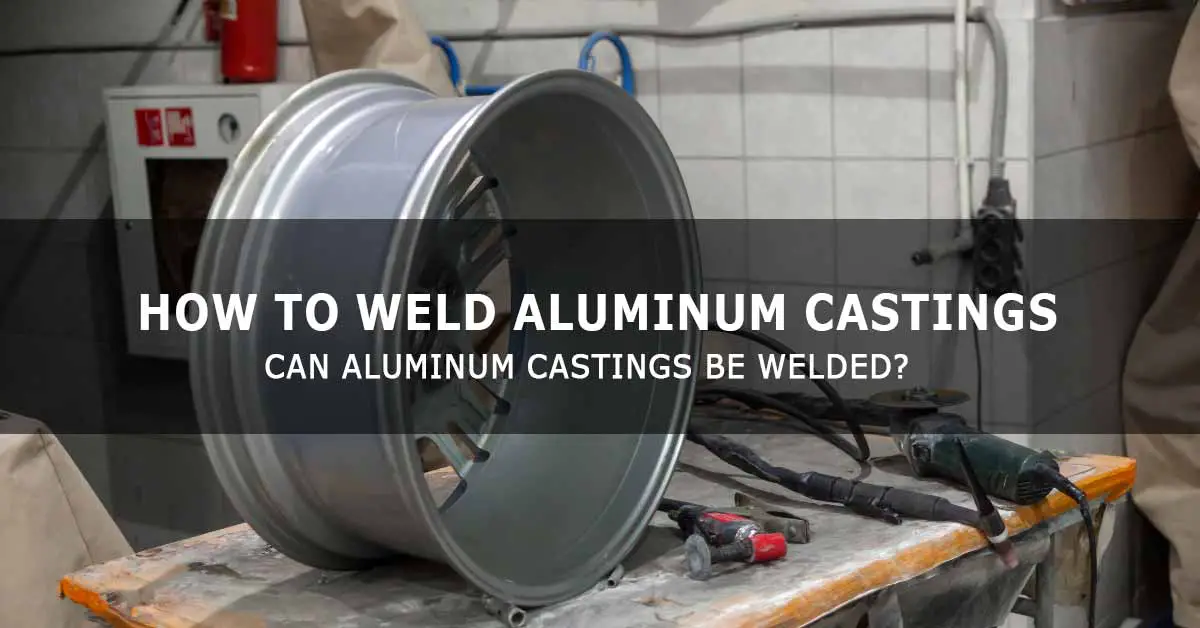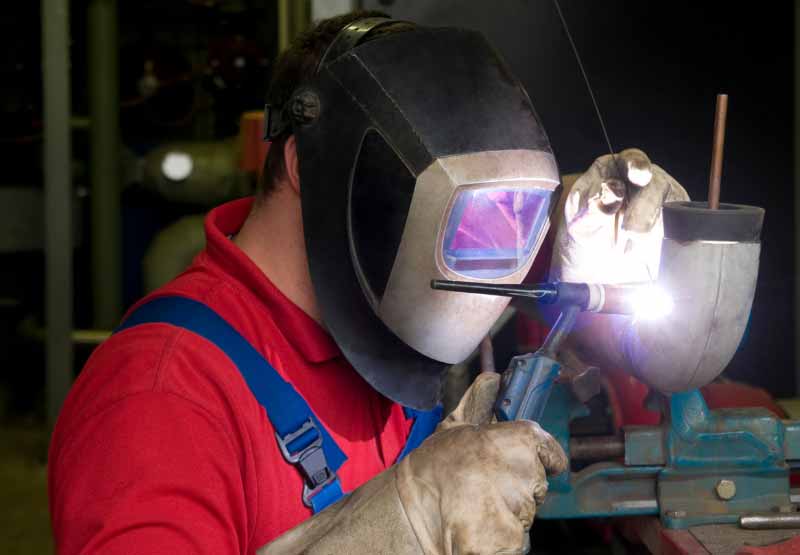How to weld aluminum castings can be a tricky subject. In fact, certain welders are split on the subject, whether it is weldable or not. The simple answer is – Yes, it is completely weldable. But if we are to get into the nitty-gritty of it, then the answer is much more complex.
Our article is here to talk about the other side, the detailed side. Like which aluminum brazing rod to use or which method works best to weld aluminum castings.
Can we weld aluminum castings?
It is absolutely true that most aluminum castings are readily weldable. However, the level of weldability depends on many factors. The two most important questions that need to be asked here are “Is the composition of the casting weldable?” and “How was the casting made?”
First of all, most of the aluminum castings come from the heat-treatable 3XX.0 series. These include 356.0, 357.0, and 319.0, which are aluminum-silicon-magnesium alloys. But some 319.0 also contain copper. All of these can easily and without question be welded using a 4043 as filler wire.
Other common types of aluminum castings include AlMg 5XX.0 alloys, which include 535.0. These are actually not heat-treatable but are also readily weldable with the help of a 5356 filler rod. However, the 7XX.0 aluminum-zinc casting alloys are considered fairly difficult to weld, even though they are heat-treatable. Actually, some of them are considered completely unweldable.
Secondly, aluminum castings are created using many different castings processes. Some of the more notable ones include die casting, investment casting, permanent mold casting, or green sand casting.
Sand castings, investment castings, and permanent mold casting are all considered completely weldable. This is because, in this case, molten aluminum is cast into a mold that possesses somewhat poor thermal conductivity properties, meaning that the castings take more time to solidify. With it cooling down much slower, all of the gasses from the molten aluminum have a chance to escape out.
But die casting is the odd one out here. The processes used here involve molten aluminum which is pressure-injected into a water-cooled steel mold. Due to the casting cooling down much quicker, in this case, the created gasses are not able to escape. This results in the creation of gas pockets in the castings themselves. These gas pockets make things very inconvenient for welders as you have to grind them out or repair weld them.
How do you know if are dealing with die casting?
There are a few ways to determine whether you are dealing with die casting. The first and most notable way is looking at the surface. If it is smoother than other castings, then it is definitely a die casting. Secondly, if you notice the presence of four to ten ejector pin marks about ⅛ inches in diameter both on the inner and outer parts of the surface.
The ejector pins usually open and pop the casting out of the die. If these marks are missing, then you are not dealing with die casting.
What is the best way to weld cast aluminum?
There are a few ways that welders use to weld aluminum castings. However, each of them involves proper preparation as the main factor. First, every piece of the aluminum cast should be treated separately, as choosing the adequate method will depend on the situation case by case.
Preheating is a good way to start. But be wary about how you do it as it can reduce the strength of the materials you are planning to weld. Also, preheating is not advised when trying to return a part to a specific heat treatment condition. It will also make choosing the filler material a nightmare.
Also, castings that require heat treatment need to be heat-treated after you finish welding them. Welding heat-treated castings reduce the tensile properties of the material. That is why a post-weld heat treatment application will restore some of the properties if the accurate filler alloy is used.
Grinding with a die grinder should also be considered as part of preparation. However, welders should avoid using oils or other grinding aids. If you still end up using them, it is better to go for acetone first, followed by alcohol, and wipe down the parts just before welding. Also, be sure not to weld anything until all the chemicals have evaporated.
TIG weld aluminum castings
We already know that TIG welding cast aluminum is tricky. But to do it as best as possible, there are some best practices that you can try.
- Clean the piece that you are welding as thoroughly as possible.
- You can preheat it at around 200°F.
- Set the AC balance at 65% or less.
- Do a cleaning pass first, use the arc to etch the surface before creating a weld puddle.
- Use a forward and backward technique to flow the weld metal before flowing the puddle with adequate amperage.
- A 4047 welding rod is softer than the 4043 wire but offers less prosody.
MIG weld aluminum castings
MIG welding is hard. MIG welding aluminum is harder. MIG welding cast aluminum is the hardest. This shouldn’t be your go-to choice when making cast-aluminum repairs. As there are other ways of doing it, resorting to MIG welding should be your last option.
But if you still decide to do it, using a 250amp TA welder with an HTP spool gun is a good way to start. Cleaning out the section that you are planning to repair is very important. A 4” grinder works paired with some acetone to finish the job.
A good piece of advice is running a few test beads on some scrap metal. Since too much heat can melt the aluminum and too low will not get it started, determining the right amount of it on some scrap should prepare you for the final job. Grind the beads and trim the edges, and you should be done.
Brazing aluminum castings
Since cast aluminum is a strong and durable alloy, brazing cast aluminum could be a perfect choice. Both Super Alloy 1 and Super Alloy 5 Aluminum brazing rods are suitable for repairing aluminum, but only the latter is acceptable for repairing cast aluminum. You also need an oxyacetylene torch for this process as well.
The higher the melting temperature, the stronger the bond. Besides being able to choose the correct alloy rod, you also need to pick the one with the right diameter. Super Alloy 1 comes in 1/8″ and 3/32″ diameter, while Super Alloy 5, the one that we need, goes between 1/16″ and 3/32″ diameter. The thicker the parent metal is, the smaller the rod will be that you will need to use. You don’t want to pick a thicker one as it will cause overheating. But if the parent metal is thicker, you are going to want a large diameter wire to avoid burn-throughs.
Basically, the best combination when brazing aluminum cast is a Super Alloy 5 wire of 3/32 diameter paired with oxygen fueled torch.
What kind of welder do I need to weld cast aluminum?
The choice of the welder you are going to use for cast aluminum welding will greatly depend on the process you will be using – MIG, TIG, or brazing. But whatever the welder or the process you decide to go with, preparation is still key. Aluminum casts are still aluminum, but you never know which type of aluminum alloy or even other types of metal the manufacturer used to create it.
Making your best guess is not an option, but proper preparation definitely is. We suggest using a welder that enables you to clean the surface. An AC TIG welder can do the job remarkably well. In the case of brazing, a welder with an oxyacetylene torch is what you need to combine with a proper brazing rod, of course. Since MIG welding cast aluminum is the hardest choice, a 250amp TA welder is what we recommend, but only if you really have to.
Final Verdict
In the end, nobody really wants to do some cast aluminum repairs. It can be flimsy and touchy to do, but it can be done with proper preparation. In this case, the method you need to use and proper preparation will ultimately help you do the job right. Of course, the best thing is knowing the compound of the parent metal, but since this is not always an option, doing the best job with what you got is still possible.
Clean, clean, clean! Be sure to treat the welding surface correctly and apply the given method with adequate heat. We wish you all the luck with this one.
References:








